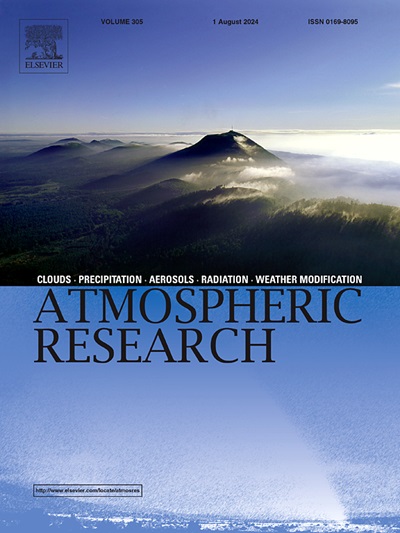塞萨洛尼基地区温室气体的局地和区域增强,由地基FTIR测量推断
IF 4.5
2区 地球科学
Q1 METEOROLOGY & ATMOSPHERIC SCIENCES
引用次数: 0
摘要
全球变暖和随之而来的气候变化是当前科学界和社会的一个重大问题。因此,持续监测影响进出能量平衡的温室气体浓度非常重要。为此,自2019年1月起,一台便携式布鲁克EM27/SUN傅立叶变换红外光谱仪在希腊塞萨洛尼基投入使用,测量柱平均干燥空气中痕量气体的总摩尔分数,简称X气体。在这项研究中,我们展示了现有温室气体(GHGs)测量数据在确定浓度增加来源方面的效用。哥白尼大气监测服务(CAMS)的再分析数据与傅立叶变换红外光谱测量数据协同使用。XCO2 显示出明显的年增长率(每年超过 2.2 ppm)和明显的季节性变化,在寒冷季节浓度增加,而在夏季由于光合作用活动浓度降低。XCH4 呈逐年上升趋势。2021 年 7 月和 8 月期间,雅典和北埃维亚连续发生火灾,导致一氧化碳浓度空前增加,与塞萨洛尼基 8 月份的典型平均值相比,增幅超过 130%。在本文中,我们研究了一氧化碳-二氧化碳和一氧化碳-碳氢化合物的增加与盛行风向之间的季节相关性,并探讨了风向和风速等气象参数是否能揭示 X 气体变化增强的原因。我们采用了两种不同的方法来检测痕量气体的长期和短期信号。总的来说,在傅立叶变换红外光谱测量中,在夏季和秋季的低速和中速风中,XCO2、XCO 和 XCH4 会增强。主要来自西南方向的风将 2021 年夏季雅典和北埃维亚附近大火产生的大量 CO2、CO 和 CH4 吹到了塞萨洛尼基。大火排放的目标气体柱变化较大(在南风和西南风方向超过 0.022 ppm)。本文章由计算机程序翻译,如有差异,请以英文原文为准。
Local and regional enhancements of GHGs in Thessaloniki, inferred from ground-based FTIR measurements
Global warming and subsequent climate change are currently a major issue both in the scientific community and the society. Therefore it is highly important to consistently monitor the concentrations of greenhouse gases that affect the incoming-outgoing energy balance. To that end, a portable Bruker EM27/SUN FTIR spectrometer is operated in Thessaloniki, Greece since January 2019, performing measurements of total column-averaged dry air mole fractions of trace gases, denoted as X-gases. In this study, we demonstrate the utility of available measurements of greenhouse gases (GHGs) to identify the origin of enhanced concentrations. Copernicus Atmosphere Monitoring Service (CAMS) reanalysis data are used synergetically with FTIR measurements. XCO2 shows an obvious annual increase (over 2.2 ppm per year) and a clear seasonal variation with high increased concentrations during cold season and decreased concentration during summer period due to photosynthesis activity. XCH4 shows an annual increase and a positive trend. The continuous fire episodes in Athens and North Evia during July and August 2021 led to an unprecedented increase in the concentrations of CO of over 130 %, compared to the typical averaged mean values during August in Thessaloniki. In this paper we investigate the seasonal dependency between CO-CO2 and CO-CH4 enhancements with respect to the prevailing wind direction and we examine if meteorological parameters, such as wind direction and speed, could reveal the origin of enhanced X-gas variations. We applied two different approaching methods to detect long-term and short-term signals of the trace gases. In general, concerning the FTIR measurements, during summer and autumn XCO2, XCO and XCH4 enhancements are observed for low and medium speed winds. Winds mainly originating from SW directions have transported large amounts of CO2, CO and CH4 from the big fires near Athens and N. Evia in summer 2021 to Thessaloniki. The fire emissions generate higher variability of the columns of target gases (over 0.022 ppm in the S and SW wind direction).
求助全文
通过发布文献求助,成功后即可免费获取论文全文。
去求助
来源期刊

Atmospheric Research
地学-气象与大气科学
CiteScore
9.40
自引率
10.90%
发文量
460
审稿时长
47 days
期刊介绍:
The journal publishes scientific papers (research papers, review articles, letters and notes) dealing with the part of the atmosphere where meteorological events occur. Attention is given to all processes extending from the earth surface to the tropopause, but special emphasis continues to be devoted to the physics of clouds, mesoscale meteorology and air pollution, i.e. atmospheric aerosols; microphysical processes; cloud dynamics and thermodynamics; numerical simulation, climatology, climate change and weather modification.
 求助内容:
求助内容: 应助结果提醒方式:
应助结果提醒方式:


